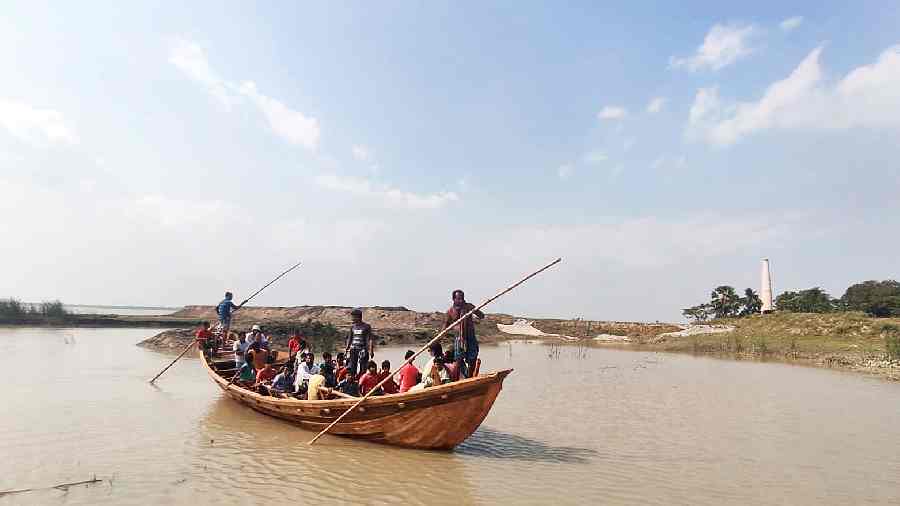A newly-built ‘Chhot’ boat with a geographical tag of Shyampur, Howrah, set sail in the waters of the Roopnarayan river on Thursday.
Built over a month with financial aid from the Endangered Material Knowledge Programme (EMKP) of the UK, the ‘Chhot’ boat was typically used by fishermen of Shyampur to navigate the choppy waters of Roopnarayan and go into the sea for a good haul of fish.
It’s a deep, V-shaped boat that is 3.5 feet tall and needs at least six feet of water to sail. Sadly, the Roopnarayan today is silted and shallow and the ‘Chhot’ boat is no longer used by the fishermen here.
However, the endangered boat-making procedure has been documented in detail by Zeeshan Ali Shaikh, a maritime archaeologist and ethnographer.
It was Shaikh, who is working on boats on the western coast of the Indian Ocean, got this project going with the help of his Facebook friend Swarup Bhattacharya.
Bhattacharya is a visiting fellow of the Anthropological Survey of India who has been researching the maritime history of the eastern coast of India for over three decades.
Swarup put forward the project proposal of documenting ‘Chhot’ boat-making and Shaikh got in touch with John Cooper of the Exeter University of UK, who represented EMKP and got them to fund the project.
Cooper said: “The reason for this project is to follow the building of the boat from start to finish.”
‘Chhot’ boat is a smooth-skinned, stapled and robust boat of Bengal which can ply the coastal regions and also go into the sea. “It’s a unique boat, with a cross-sectional V-shape that maintains its buoyancy. We lost the tradition of this boatmaking 30 years ago. At present, there are some boat builders who still know how to build a ‘Chhot’ boat. But the knowledge will be lost so it is important to record the technology,” said Cooper.
In the Mistri Para of Dihimondal Ghat in Shyampur, every Namasudra family once knew how to build a “Chhot” boat.
Over time, with no demand for such boats, the know-how is lost except for one family of boatmakers here.
Panchanan Mondal and his four sons have made the ‘Chhot’ boat for this project.
“Mondal is the main carpenter who knows how to build the boat. His elder son Amal, too, knows. But his other three sons are into other work and don’t know how to build the boat,” said Swarup.
“The last time I built a Chhot boat was 30 years ago,” said 70-year-old Panchanan. “We use Arjun wood, babla wood, neem wood to build this boat. The wood is sawed and cut in shape in the mills. A lot of glue is made from a local fruit called gab and cotton is used as sealants. The wood is stapled with 60kg of nails. The boat is 37 feet in length and about 4 feet in height. About Rs 3.5 lakh has been spent to build this boat. The EMKP has funded it,” said Panchanan Mondal.
The boat, now finished, has an eye and a mast. It was put in the water for the first time today and set sail while the tide was high. While the boat will be sent to the National Maritime Museum in Gujarat, the entire data on documentation will be preserved in the British Museum.
“What we are trying to achieve is reconstruct the process of Chhot making and sailing and performance and activities on the Chhot boat. We are mainly video-recording and doing line drawings and sketches and interviewers with the boat builders,” said Shaikh.
EMKP is based in British Museum but it is funded by the London-based organisation called the Arcadia Fund.
“The Arcadia Fund and EMKP fund crafted projects all over the world and they are focussing on recording a craft that is endangered. This process of stapling wood to build a boat is typically done in West Bengal,” said Cooper. It is an international project with collaboration from the University of Exeter represented by John Cooper, Vasant Shinde from the Central University of Haryana and Zeeshan Shaikh and Swarup Bhattacharya.
“The data will be part of the EMKP archive which is open-access and globally available to everybody,” said Shaikh.
